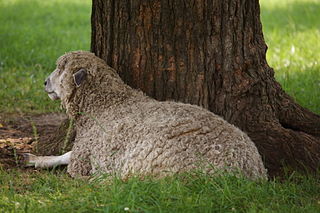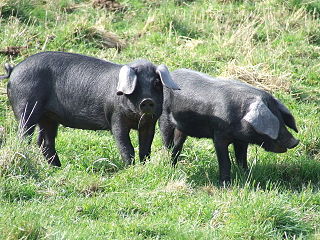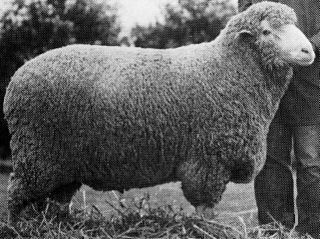Related Research Articles

A landrace is a domesticated, locally adapted, traditional variety of a species of animal or plant that has developed over time, through adaptation to its natural and cultural environment of agriculture and pastoralism, and due to isolation from other populations of the species. Landraces are generally distinguished from cultivars, and from breeds in the standardized sense, although the term landrace breed is sometimes used as distinguished from the term standardized breed when referring to cattle.

The Border Leicester is a British breed of sheep. It is a polled, long-wool sheep and is considered a dual-purpose breed as it is reared both for meat and for wool. The sheep are large but docile. They have been exported to other sheep-producing regions, including Australia and the United States.

The Jacob is a British breed of domestic sheep. It combines two characteristics unusual in sheep: it is piebald—dark-coloured with areas of white wool—and it is often polycerate or multi-horned. It most commonly has four horns. The origin of the breed is not known; broken-coloured polycerate sheep were present in England by the middle of the seventeenth century, and were widespread a century later. A breed society was formed in 1969, and a flock book was published from 1972.

The Shropshire breed of domestic sheep originated from the hills of Shropshire, and North Staffordshire, England, during the 1840s. The breeders in the area used the local horned black-faced sheep and crossed them with a few breeds of white-faced sheep. This produced a medium-sized polled (hornless) sheep that produced good wool and meat. In 1855 the first Shropshires were imported into the United States (Virginia). This breed is raised primarily for meat.

The Ryeland is one of the oldest English sheep breeds going back seven centuries when the monks of Leominster in Herefordshire bred sheep and grazed them on the rye pastures, giving them their name. It was introduced into Australia in 1919 and are classified as an endangered breed by the Rare Breeds Trust of Australia and also are one of the nine heritage breeds that were the foundation of the sheep and wool industry in Australia. The Ryeland was one of the breeds used to introduce the poll gene to the Dorset breed in the development of the Poll Dorset. This breed is raised primarily for meat.

The Suffolk is a British breed of domestic sheep. It originated in the late eighteenth century in the area of Bury St. Edmunds in Suffolk, as a result of cross-breeding when Norfolk Horn ewes were put to improved Southdown rams. It is a polled, black-faced breed, and is raised primarily for its meat. It has been exported to many countries, and is among the most numerous breeds of sheep worldwide.

The Barbados Black Belly is a breed of domestic sheep from the Caribbean island of Barbados. Although it is likely the Barbados Blackbelly has African ancestry, there seems to be clear evidence that the breed, as seen today, was developed by the people on the island from sheep brought by ships fairly early in the period after Europeans first arrived. This breed is raised primarily for meat. It is widely distributed, with populations in twenty-five countries in the Americas, Asia and Europe. It is most abundant in the Caribbean region, in Mexico and in Peru. In 2015 the total world population was estimated at about 158,000. In 2014, the US reported 1,971 registered sheep.

The Dorper is a South African breed of domestic sheep developed by crossing Dorset Horn and the Blackhead Persian sheep. The breed was created through the efforts of the South African Department of Agriculture to breed a meat sheep suitable to the more arid regions of the country. It is now farmed in other areas as well, and is the second most common sheep breed in South Africa.

Not to be confused with the Olde English 'Babydoll' Southdown sheep.

The Romney, formerly called the Romney Marsh sheep but generally referred to by the local farmers as the Kent, is a breed of sheep originating in England. The Romney is a "long-wool" breed recognized in England by 1800. Exported to other continents, the Romney is an economically important sheep breed, especially to the sheep-meat and wool export trades of New Zealand.
The Finnish Landrace, Finn or Finnsheep is a breed of domestic sheep native to Finland. It is one of several Northern European short-tailed sheep breeds, but is notable for its high incidence of multiple births – it is common for a ewe to have three, four, or even five lambs at once.

The Leicester Longwool is an English breed of sheep. Alternative names for the breed include: Leicester, Bakewell Leicester, Dishley Leicester, English Leicester, Improved Leicester and New Leicester. It was originally developed by 18th-century breeding innovator Robert Bakewell.

The Dorset Horn is an endangered British breed of domestic sheep. It is documented from the seventeenth century, and is highly prolific, sometimes producing two lambing seasons per year. Among British sheep, it is the only breed capable of breeding throughout the winter.

The Large Black pig is a British breed of domestic pig. It is the only British pig that is entirely black. It was created in the last years of the nineteenth century by merging the black pig populations of Devon and Cornwall in the south-west with those of Essex, Suffolk and Kent in the south-east. It is hardy, docile and prolific; it forages well and is suitable for extensive farming, but not well suited to intensive management.

The St Croix is a breed of domestic sheep native to the U.S. Virgin Islands and named for the island of Saint Croix. They are often also called Virgin Island White because those that were imported into North America were selected for white coloration. On the Island of St. Croix, they come in shades of brown, white and black.

Bond sheep are an Australian sheep breed that was developed around 1909 near Lockhart, New South Wales by Thomas Bond when he mated Saxon-Peppin Merino ewes to stud Lincoln rams for primarily wool production. The resulting progeny was selected on the basis that they would be more suited to the Riverina environment. Initially these sheep were known as ‘the Commercial Corriedale’.

Sheep are quadrupedal, ruminant mammals typically kept as livestock. Like all ruminants, sheep are members of the order Artiodactyla, the even-toed ungulates. Although the name sheep applies to many species in the genus Ovis, in everyday usage it almost always refers to Ovis aries. Numbering a little over one billion, domestic sheep are also the most numerous species of sheep. An adult female is referred to as a ewe, an intact male as a ram, occasionally a tup, a castrated male as a wether, and a young sheep as a lamb.
The West African Dwarf or Djallonké is an African breed or group of breeds of domestic sheep. It is the dominant breed of West and Central Africa. This breed is primarily raised for meat.

The Meatmaster is a breed of domestic sheep native to South Africa. Bred in the early 1990s from various hair sheep breeds, the Meatmaster was created with the goal of improving the meat characteristics of African fat-tailed sheep breeds. The fat-tailed sheep had various advantageous characteristics such as hardiness and suitability for desert life, but was slow to mature, had a poor distribution of fat and lacked the muscling of the hind quarters of European breeds. The composite breed increased the amount of muscle and had a better distribution of fat but retained the hair coat and other desirable traits such as resistance to tick-borne diseases and a good flocking instinct.

Australian White is a large, white breed of Australian meat sheep which was originally developed for Australian conditions. The Australian White sheep are a stabilised composite haired meat breed comprising White Dorper, Van Rooy, Poll Dorset and Texel genetics.
References
- ↑ "Van Rooy". ansi.okstate.edu. Oklahoma State University Dept. of Animal Science.
- ↑ FCS Animal Production L3. Pearson South Africa. 2008. pp. 93–94. ISBN 978-1-77025-118-2.
- ↑ "Domestic Animal Diversity Information System". FAO.
- ↑ "Van Rooy Sheep". Genelink. Retrieved 30 April 2011.
- ↑ "Australian White Sheep". The Australian White Sheep Breeders’ Association of Australia. Retrieved 4 May 2011.